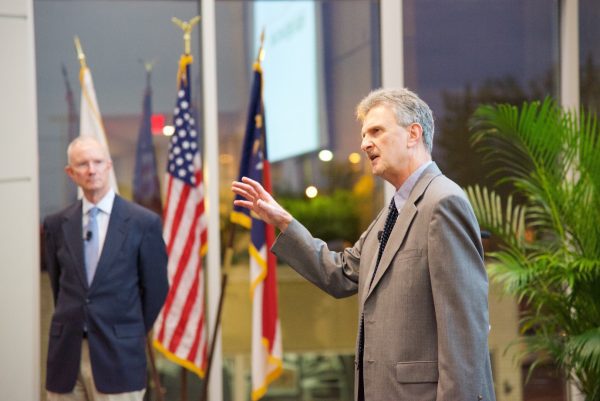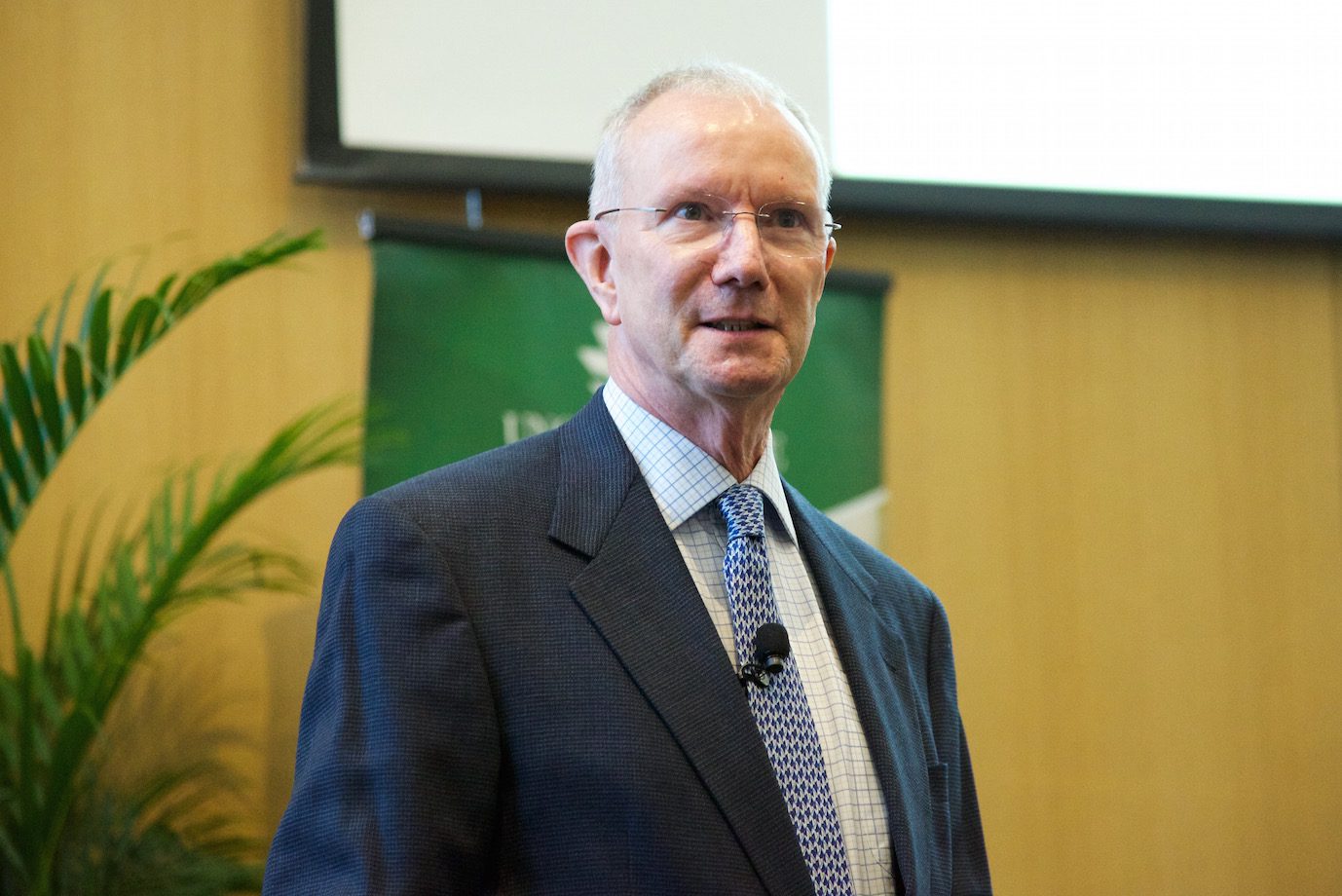Research Illuminates How Trauma Can Lead to Growth

The man waited off to the side as Richard Tedeschi finished his remarks and then, as the audience was filtering out, made his way over to Tedeschi. Something was on his mind.
The fourth annual UNC Charlotte Veterans’ Health Conference had drawn crowds eager to discuss veterans’ reintegration into civilian life. The attendee, a young veteran, described to Tedeschi a horrific event he experienced while serving in the military. The emotional aftershocks leveled his life. He spent years afterward doing little except isolating himself and struggling with depression.
“But then he roused himself and started going back to school,” says Tedeschi, professor in UNC Charlotte’s Department of Psychological Science. “He has a plan for how more education is going to give him an opportunity to be of service again. He recognizes he’s on a new mission.”
This story of a person who rises from trauma and grief to experience something new in himself is one Tedeschi has heard from people young and old, from every walk of life. He and fellow researcher Lawrence Calhoun, UNC Charlotte emeritus professor in psychology, years ago coined the phrase “posttraumatic growth” to describe what they have witnessed – that some people will grow and change in new ways after they undergo trauma.
Tedeschi and Calhoun – both practicing clinicians as well as researchers – have published widely on the topic and their work has been cited around the world in academic publications, newspapers and magazines. In one of their books, Posttraumatic Growth in Clinical Practice, these pioneers offered clinicians and laymen helpful suggestions, based on practical experience, for dealing with trauma survivors.
Their work has continued to grow and evolve, as they find new avenues of research, gain new collaborators, mentor new students and influence other researchers and authors of popular press books. Recently, best-selling authors Sheryl Sandberg and Adam Grant cite the UNC Charlotte researchers’ work in their acclaimed book, Option B.
Yet, when they first introduced the concept of posttraumatic growth in the mid-1990s, it represented a dramatic departure from the way psychologists and laypeople regarded trauma.
“I think there are assumptions people make about trauma, that it invariably results in a psychological disorder or emotional disorder of some kind,” Tedeschi says.
Other myths abound: that “time heals all wounds” or that people who undergo trauma do best to put away the experience and force themselves to move on. Instead, the work that Tedeschi, Calhoun and colleagues have done shows that the aftermath of trauma can be the most important factor in what the person experiences.
“When people are confronted with very negative sets of circumstances and by being forced to deal with them, many are changed in ways they think are very positive,” Calhoun says.
The circumstances the researchers focused on were no mere setbacks for the people involved. These events were deeply wrenching: Permanent, life-altering injuries. Rape. Genocide. The loss of a spouse. The death of a child.
“One of the common elements that’s a precursor to the possibility of posttraumatic growth is that whatever happens, it has to shake the foundations of someone’s understanding of the world and their place in it,” Calhoun says. “Things do not compute right away after the event. It’s kind of like an earthquake. Earthquakes shake buildings, and may cause the whole thing to collapse.”
Similarly, he says, “trauma teaches you very quickly that you’re not in control.”
What the researchers discovered is that for some who experience such foundation-rocking events, “positive change comes from the struggle,” Calhoun says.
 That’s an important note: It is not that the trauma itself worked some good in someone’s life, he says. The journey through the pain is what brings about change. The researchers emphasize that posttraumatic growth never erases pain.
That’s an important note: It is not that the trauma itself worked some good in someone’s life, he says. The journey through the pain is what brings about change. The researchers emphasize that posttraumatic growth never erases pain.
“We’re not saying trauma is a good thing for people,” Tedeschi says. “Traumas aren’t good for people. Even people who experience growth hurt. We’re focused on ‘what then.’ ”
This concept is not about pain and loss making people resilient, Calhoun noted. For many people experiencing posttraumatic growth, the positive change includes a deep recognition of just how fragile they really are.
“People say, ‘I am more vulnerable than I thought and stronger than I ever imagined,’ ” Calhoun says. “There is an awareness that bad things can happen to good people.”
Posttraumatic growth looks different for different people, but Tedeschi and Calhoun have seen common themes emerge from their studies and those of colleagues with the Posttraumatic Growth Research Group, based at UNC Charlotte. The growth can show up as a newfound personal strength, more robust relationships, a deeper compassion for others and a change in one’s philosophy of life – such as a shift in one’s spirituality, a greater appreciation for life or the discovery of new possibilities.
“I’ve worked with people who have experienced serious medical problems that have prevented them from continuing to work and be active in the way they used to,” Tedeschi says. “It’s easy to think about that as the end of life and not having much purpose or strength or capability anymore.”
Yet, some have discovered that they can approach life differently, he says. “I’ve had people talk about how, despite their disability, they’re making different use of the time they have – slowing down, being more observant and appreciative. Taking time to listen to other people and talk to other people and connect in their relationships. Being brought to a halt in one way in their lives allowed them to use this extra time to live life in a more meaningful way.”
 This understanding – that the aftermath of trauma contains the seeds of something new – is starting to change the way military veterans suffering posttraumatic stress disorder are treated. Depending on their service era, according to the Department of Veterans Affairs, anywhere from 11 percent to 20 percent of veterans suffer PTSD, a condition in which stress and anxiety reactions from a horrific event disrupt life and change personalities.
This understanding – that the aftermath of trauma contains the seeds of something new – is starting to change the way military veterans suffering posttraumatic stress disorder are treated. Depending on their service era, according to the Department of Veterans Affairs, anywhere from 11 percent to 20 percent of veterans suffer PTSD, a condition in which stress and anxiety reactions from a horrific event disrupt life and change personalities.
The researchers have realized that PTSD and posttraumatic growth “are children of the same parents,” Calhoun says. For many, traditional methods of treating PTSD, such as exposure therapy, in which people may repeatedly discuss traumatic events in order to lessen the distress they cause – just do not work.
Tedeschi is studying the outcomes of a veterans program that instead aims to foster posttraumatic growth. Warrior PATHH (Progressive and Alternative Training for Healing Heroes), is a Virginia-based program based at a rural retreat center in the Blue Ridge Mountains. There, combat veterans and their families spend days active in the outdoors, talking with fellow veterans rather than clinicians. Rather than endlessly discussing the trauma they suffered in combat, they explore their motivations for enlisting, their family backgrounds, and how they can weave into their new civilian selves the personal qualities that made them successful on the battlefield. Tedeschi says outcomes suggest the new approach is working.
The standard ways of addressing PTSD, Tedeschi told The Washington Post in a story about the program, “understandably focused on reducing distress symptoms.” With the new approach, he says, “we’re trying to focus on trauma survivorship.”
Treating veterans’ invisible wounds with posttraumatic growth as part of the equation means helping the veterans see that they have new, valuable roles to play and much to offer, despite their struggles, Tedeschi says. The approach does not focus on taking veterans back to the way they used to be, because trauma erases any such “used-to-be,” he says. Instead, the veterans find new paths that exist alongside pain.
The UNC Charlotte researchers have watched over the years as their findings about posttraumatic growth, initially greeted with skepticism, have become embraced by the psychology community and public in general.
“Professionals, in the past, were more surprised by our findings than non-clinicians,” Calhoun says. “We know this because we have had numerous laypeople over the years write us and say ‘Thank God, you’ve given a name for what I’ve experienced’ and ‘I didn’t know other people had experienced what I had gone through.’ ”
Now, the researchers have turned their attention to examining posttraumatic growth in other cultures.
“We’re looking at how our measures of this concept work in other places – in Japan, Nepal, China and Turkey – and we’re finding that the concept resonates with people no matter where they are,” Tedeschi says. “It seems to have a universal quality to it.”
Universal and affirming, they say. “That’s what’s so gratifying about this work,” Tedeschi says. “You get to find out how amazing people really are.”
Words: Amber Veverka | Images: Lynn Roberson.
First image: Tedeschi (right) comments at a community talk; second image: Calhoun answers a question; third image: the researchers are in high demand to share the research that continues to impact many people’s lives. UPDATE: This article first appeared in 2017. Since then, Tedeschi has joined Calhoun as faculty emeritus. The two are still hard at work, however. Their latest book, “Posttraumatic growth: Theory, research, and applications,” was published by Routledge in 2018 with Jane Shakespeare-Finch and Kanako Taku.